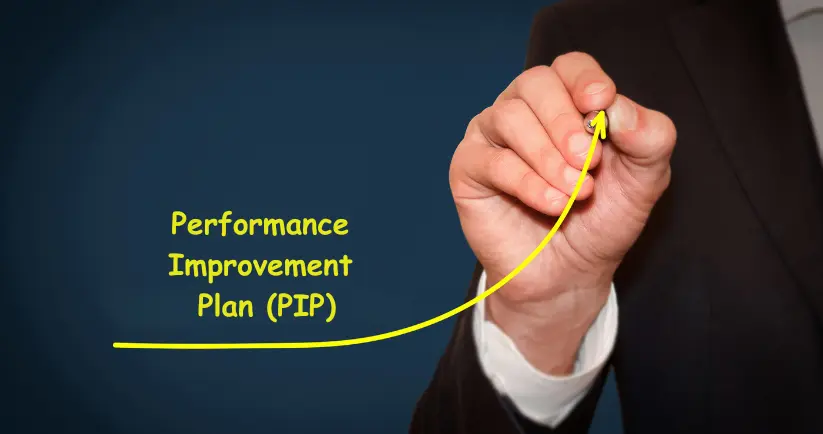
All About Employee Performance Improvement Plan (PIP)
Table of Contents

Reading Time: 11 minutes
What is a Performance Improvement Plan (PIP)?
The full form of PIP is Performance Improvement Plan. A performance improvement plan (PIP), is a documented performance improvement tool used by the employer to outline the areas of improvements required for the employees who do not meet the performance expectations of the organization.
The primary objective of a Performance Improvement Plan (PIP) is to provide a framework for the employee who is lacking in specific areas of their performance, resulting in immediate course of action for improvement. Hence, HR teams utilize performance management software to provide their employees with a clear idea of the improvements they wish to observe in their performance.
The employee needs to adhere to the Performance improvement plan to get clarity on their actual performances and the expected performances set by the employers. It also provides support and assistance in getting the performance standards achieved by the employee which further fosters employee connection with the organization.
The key element of a performance improvement plan (PIP) is:
- It provides clear expectations of employers towards the performance standard of employees.
- Sets a timeline within which the employee’s performance needs improvement.
- Support the employee to improve their performances by providing training and assistance during the PIP period
- Both the employer and the employee sign the PIP document to acknowledge their understanding and accomplishment of the listed performance standards, etc.
Now that we have a comprehensive understanding of the employee PIP, let’s explore the benefits of a performance improvement plan, the steps to achieve it, and more. However, we also follow a performance management system to improve employee performance more strategically.
What are the benefits of an Employee Performance Improvement Plan?
The employee performance improvement plans can be a significant tool for both the employer and employee as they hold prominence in various elements which include:
➔ Transparent Expectations
A performance improvement plan exhibits clear expectations of employers regarding the performance standards of employees, which enhances transparency in communication and eliminates perplexities and confusion.
A PIP is a written concrete document with the acknowledgment of understanding of both the employers and employees, which makes it more authentic and legitimate in terms of conveying the set objectives to improve employee performance.
A performance improvement plan document contains clear and specific action requirements for the employees’ performances, which makes it easier for the employees to understand what to improve and within what time frame.
➔ Nullify Legal Lawsuits
A performance improvement plan nullifies the legal lawsuit tension that arises due to the unauthorized termination of employees without proper reasoning.
It protects employees from legal issues that are initiated by the employees for deceitful or wrongful terminations, as it is a documented tool that has the signatures of both the employer and employee.
A PIP also gives a fair chance to the underperforming employees to work on their performance deficiencies and improve their standards before initiating any serious disciplinary action, including terminations.
The written document also serves as proof of mutual agreement between employer and employee and eliminates deviation from the said objectives and accomplishments of expectations.
➔ Structured & Regular Feedback
A performance improvement plan (PIP) helps the employer in keeping regular check-ins and providing constructive feedback to the employees. It also keeps a watch on employees’ action plan and guide them in case of diversion.
A PIP is a recorded validation that possesses the understanding and approval of both the employers and the employees.
Hence, it becomes convenient for employers to initiate regular check-ins into the ongoing performance as per the performance improvement plans.
Regular Feedback from employers assists employees in the accomplishment of the plan of action and also provides support for the challenges that arise during the process of objective accomplishment.
➔ Enhance Motivation
A performance improvement plan, PIP is a motivational tool for underperforming employees as it gives them a fair chance to prove their potential in their plight and get support from employers during their course of action.
Furthermore, the assistance provided during the process strengthens the employee relationship with the organization and helps them gain knowledge.
Realizing their performance is being monitored and that it could lead to rewarding outcomes and skill development, employee motivation surges for goal attainment.
➔ Fosters Learning
A significant major benefit of a performance improvement plan for the employee is, that it fosters the knowledge and skills of an individual who is deficient.
This as a result not only boosts their morale but also advances their skills, hence making them more efficient to perform effectively and prepare for future contingencies.
A PIP includes opportunities that are beneficial for employee growth, progression, and advancement.
➔ Eliminate Unfair Terminations
The performance improvement plan is an essential documentation of an employee’s performance deficiencies which justifies the scope or chances given to the employee to prove their potential within a specified period of time.
The reason for termination of employees could be anything including layoff due to pandemic urgency, seismic shifts in market conditions, or dismissal of the company, but if the termination of the employees is a result of unfair practices such as discrimination, biases, or other unethical reasons, such kind of layoffs are subject to legal lawsuits by the employees.
This puts the company’s reputation at threat so, PIP can be a significant tool to eliminate the risk of legal issues that arise due to unfair termination of employees.
➔ Elevates Productivity
A performance improvement plan improves the efficiency of the underperforming employees by specifying their areas of deficiency in performance.
Hence, it not only improves their performance but also sharpen their knowledge and develops their skill for future contingencies, hence enhancing the overall productivity.
Furthermore, a performance improvement plan articulates the substandard performance of an employee hence, giving a clear perspective of the areas to focus on and prioritize. This as a result nullifies the confusion in task accomplishment and increases the efficiency of the employees.
➔ Enhance Employee Connection
A performance improvement plan gives alternate chances to the underperformed employees, to prove their caliber and capacity within a specific period of time by mentioning their areas of deficiency.
It is a mutual agreement with the employee to improve their performance before taking any stringent or disciplinary action, including termination.
Furthermore, the PIP is not framed to guilt the employee, but rather to make them feel that they are important to the organization, for which to meet the organizational objective, this is a part and parcel of helping them improve their efficiency.
➔ Improve Team Dynamics
Performance improvement plans can be a significant tool to improve team dynamics in the team by contracting the tension and issues that have arisen due to the underperformance of the employee.
Furthermore, in the process of PIP attainment by the employee, the HR along with the manager of the employee works in liaison to ensure whether a PIP is improving the employee’s work standards or is deviating from the set objective.
What is the process to write a Performance Improvement Plan (PIP)?
The process of writing a Performance improvement plan includes the following:
➔ Identify the Performance Issues
A PIP should be planned by assessing the performances of the employees thoroughly and finding appropriate deficiencies that are hampering the employee workflow.
This is the foremost step that holds great significance, as this will set the plan ahead without confusion and conflicts.
Identifying the vital issues in employees’ performance that require immediate attention can also save time, hence enabling employers to prioritize tasks accordingly.
➔ Set Clear Objectives
After identifying the underlying and vibrant issues influencing the performance of the employee, the next step is to set clear objectives in the performance improvement plan.
Setting clear objectives helps the employee understand the employer’s expectations better and work in accordance to achieve them.
The objectives can be set by considering the SMART (Specific, Measurable, Achievable, Realistic, and Time-bound) approach to be specific in highlighting the expectations without any confusion.
Also Read:
➔ Develop a Supportive Action Plan
A proper, well-documented action plan should be framed to create a clear path or description of what alterations are required from the employee and how that will be effective.
Also, developing an action plan includes the following pointers, such as:
- Employee details (Name, Designation, and Department)
- Description of specific performance issue
- Timeline for its accomplishments
- Support and assistance to be provided by the organization
- Consequences of breaching or non-attainment of mentioned objectives in PIP
- A section for employees’ comment
➔ Set Timeline
Set a specific timeline for achieving the employee PIP objectives to avoid over-consumption of time.
It is pivotal as setting a time frame will enhance the employees’ capacity to work on tight deadlines and will increase their performance and productivity.
Generally, a PIP is set for 30, 60, or 90 days, but the duration can vary depending on the severity of the performance issues.
➔ Align Company Policies
Align the company policies with the performance improvement plan to increase the accuracy and accomplish the overall objective of the organization.
It is extremely important to align the PIP with the company objectives as it would not only elevate the efficiency of employees but will also help in accomplishing the required goal of the organization.
➔ Communicate the Objectives
Communicate the performance improvement plan to the employees to give them a clear insight into the performance improvement plan.
Schedule a private meeting with the employee and clarify the expectations and objectives clearly along with the guidance to be provided for the areas of deficiency in performance.
The meeting should be confidential and should initiate open communication, to allow employees to ask questions and get clarity on the action plans to be implemented.
➔ Document the PIP
Record and document the meeting including date, time, location, attendees, and discussion points for future reference or in case of diversion from the employee end to attain the objectives.
The document should be signed by both the employer and the employee to acknowledge their understanding of the performance improvement plan.
A well-documented PIP is not only essential for proof but also essential for reference during the course of action of PIP.
➔ Regular check-ins & Feedback
It is majorly significant for the employer to execute regular check-ins to assess the progress of employees and provide constructive feedback for the betterment of employees’ performance.
Set monthly or bi-weekly meetings to monitor the progress of the employees’ performances as per the PIP framed and address their concerns with constructive feedback as well as praise for improvements.
➔ Initiate assistance
To help the employee accomplish the objectives in the PIP, initiate assistance and support the employee in improving their performance.
Ensure that the employees get adequate training and support from the organization to efficiently fulfill the PIP outline within the days specified.
Also, forward support in the form of additional training, coaching, or workshops to an employee during the PIP process in case of severity of issues hindering the employee’s capacity to perform effectively.
➔ Final Evaluation
In the end, evaluate the PIP of employees’ performance to check whether the objectives are accomplished efficiently or need additional assistance for improvement.
The final evaluation of an employee’s performance is critical and highly significant to track the overall progress and take action as per the PIP.
When should you implement an Employee Performance Improvement Plan?
The performance improvement plans can be implemented for several reasons such as:
- Poor Performance– When an employee is consistent in delivering substandard performance, A PIP is outlined to assist in improving performance as well as prove credibility to sustain in the organization.
- Failure in KRA– When employees fail to meet organizational goals set by the management at the beginning of their performance, a performance improvement plan is outlined to assist an employee in accomplishing the objectives set in KRA.
- To Address Specific Issue– To improve any specific issue in the performance of the employee, a PIP can be framed to avoid wasting time resurfacing the entire performance and focus on the specific tasks that require attention.
- Non-Compliance– When the employee does not comply with the company policy or does something that does not comply with or is against the company laws, then the requirement to frame a PIP arises.
- Knowledge and Skills Gap– When an employee lacks proficient knowledge or competency to cope up with the rapidly evolving market landscape, a PIP is required to specify the knowledge or skills to be acquired.
- Recurring Issues– If the performance issues keep repeating despite several attempts in the past, a PIP can help outline the underlying reasons affecting the performance of employees.
- Performance Reviews– If the regular performance review of an employee highlights the areas of grey or deficiency in the performance, then the PIP may be used in a formal way to address and solve the issues and concerns initiating it.
- Failure in Probationary Compliance– If the new hires, fail to meet the set objective during their probation period, then the need to improve their performances requires a well-documented performance improvement plan and adequate implementation of the same.
- Lack of Response– If the employee fails to accept constructive feedback and doesn’t address the performance issues then the need to create a PIP becomes essential.
How to respond to and survive a PIP?
To respond to and survive a PIP there are certain steps to be followed:
- Stay calm– PIP is designed to help you improve performance so receiving a PIP should not affect your mental health or surge stress.
- Go-Through the PIP– After receiving the PIP, thoroughly recapitulate your areas of deficiencies and shortcomings in your performance, and make notes of the points of diversion.
- Ask– Seek clarification or ask questions to get yourself a clear perspective of the performance improvement plan and to perform it efficiently.
- Acknowledge– Acknowledge the issues underlying your performance and start with the action plan to improve it.
- Develop an Action Plan– Develop your own plan of action by aligning it with the PIP to get your objectives accomplished.
- Seek Guidance– Seek support and guidance from the manager or supervisor (whoever is in charge) to meet the goals and do not hesitate to ask questions.
- Monitor your performance– Monitor your performance regularly to evaluate how far have you achieved or what alterations are needed to achieve the required aim.
- Document Your Work– Keep a record and document your progress, training received and additional coaching (if any) received for future proof and reference.
- Seek Legal Help (If necessary)– Seek legal help if you feel PIP is discriminatory, unfair, or biased.
Employee Performance Improvement Plan Sample Template
Example: Let us consider an example of Janiet who is a Data Analyst at XYZ company and has recurring errors in data entry
[XYZ Company]
Employee Performance Improvement Plan
Employee Name: [Janiet Rose]
Position: [Data Scientist]
Department: [Data Science]
Date: [Date PIP is Issued]
Introduction: This Employee Performance Improvement Plan (PIP) is being issued to address concerns regarding recurring errors in data entry as a Data Scientist at Qualtrics.
Performance Issue: It has been noticed since the last [ Specify time period since when the issues are occurring ] that there are recurring errors in your data entry, impacting the accuracy and reliability of the analytics. Examples include [mention specific instances, e.g., inaccuracies in reports, data inconsistencies].
▸ Expected performance
- Improve accuracy by 98 percent
- Quality Check
- Improve Communication
▸ Action Plan:
- Improve data entry accuracy by double-checking the entries
- Implement rigorous quality checks before finalizing any entry
- Improve communication with team members and seek help if needed
- Actively participate in data science team meetings or sessions on data entry analytics.
▸ Timeline:
- This Performance improvement plan will be in effect from [Mention the specific date of effect] and for the next [mention the term of PIP, for example, 3 months or 6 months, etc.]
- Performance evaluations are scheduled on [ Mention date or multiple dates {if the evaluation is frequent and will be done in shorter intervals} of evaluations].
- Progress reviews will take place on [ Mention the date].
▸ Support and Resources
To assist you in meeting these expectations, we will provide the following support and resources:
- Data Entry Training: Enroll in a specialized data entry training program to enhance your skills.
- Quality Assurance Workshop: Participate in a quality assurance workshop to be organized by the company or other workshop professionals.
- Regular Feedback: Weekly check-ins will be scheduled to provide you assistance in between your PIP period and help you overcome any challenges if any.
▸ Consequences
[Mention potential consequences]
- Disciplinary actions
- Terminations
- Performance review
- probation or more.
▸ Signatures: Employee Acknowledgment:
I, Janiet Rose [Data Scientist’s Full Name], have received and reviewed this Employee Performance Improvement Plan. I understand the expectations outlined herein and agree to make sincere efforts to improve my data entry accuracy within the specified timeline.
Employee’s Signature: _______________ Date: _______________
▸ Supervisor’s Signature:
I, Sherman Malhotra [Supervisor’s Full Name], have discussed this plan with the Data Scientist and will provide the necessary support outlined in this document. I will conduct regular reviews of the Data Scientist’s progress as specified.
Supervisor’s Signature: _______________ Date: _______________
▸ Note– This is for reference purposes, PIP of different companies differs as per their company policies, demographic location, and other factors. So, it is essential for you to refer to your company’s policy before deciding on the PIP format and detailing.
FAQs
1. How long is a PIP performance improvement plan?
The duration of the PIP Performance improvement plans usually longs to 30,60 or 90 days or more depending upon the severity of the issues in performance.
2. How does PIP affect your career?
A PIP can affect your career both positively and negatively.
Positive aspects include:
- Improved performances
- Elevates confidence
- Enhanced job security
- Career growth
- Improved working relationship
- Knowledge advancements
Whereas, negative aspect includes:
- Termination
- Affects the references for future employment
- Shatters confidence
3. Does PIP lead to termination?
A PIP is typically designed to create a chance for the poor-performing employees to prove their caliber in a given period of time by improving their performance. But in case of non-compliance or failure to attain the objectives specified in a PIP, It can lead to termination.







